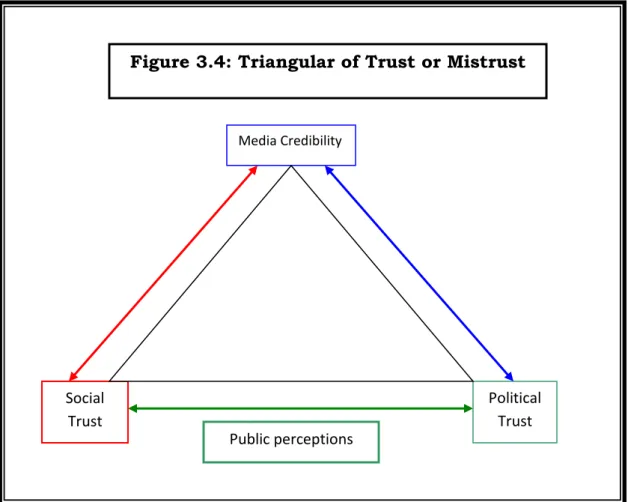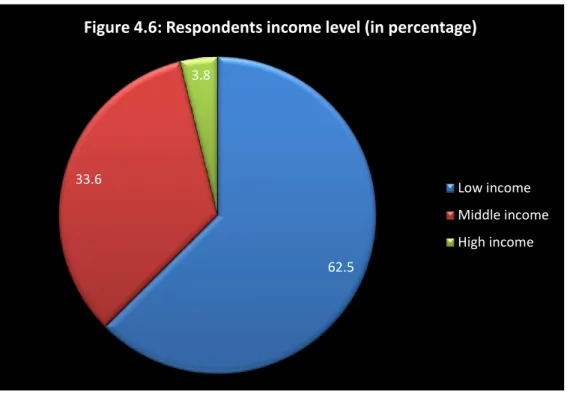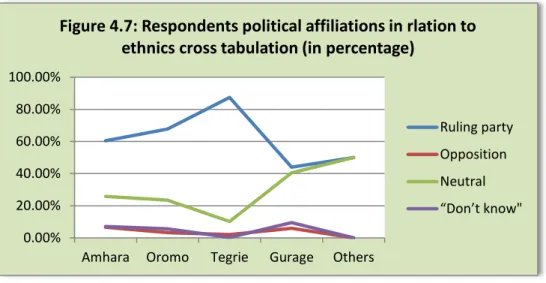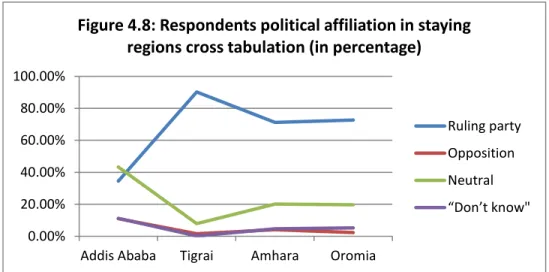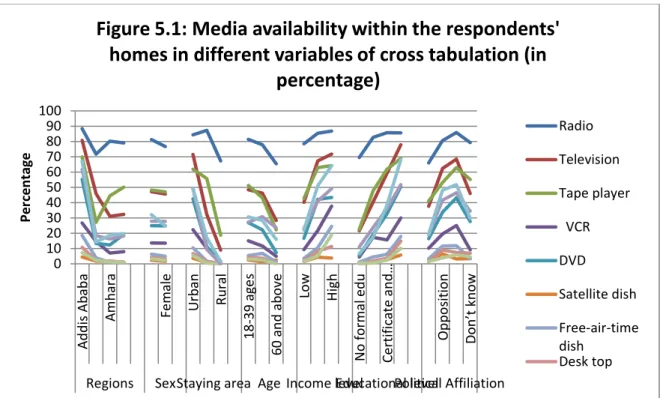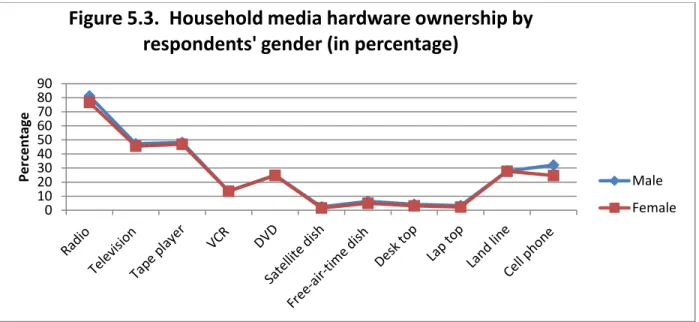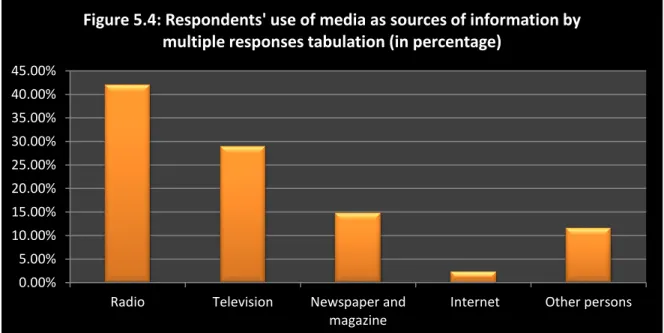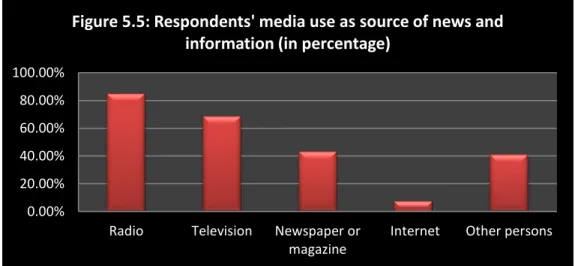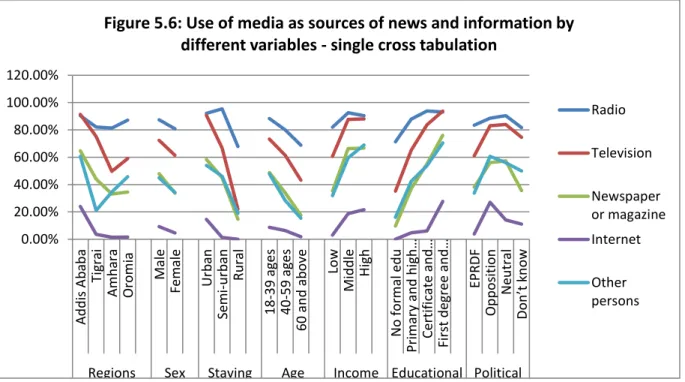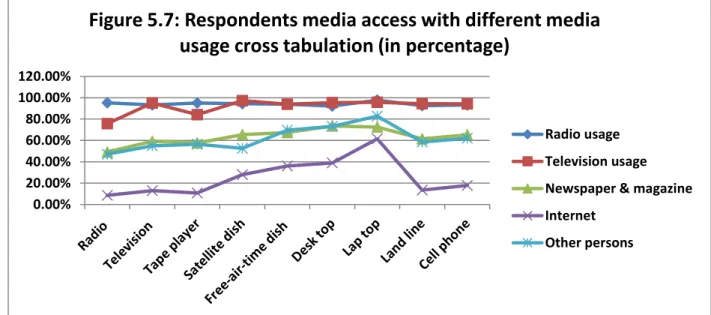‘Triangular Trust or Mistrust?’: Social trust, political trust and news media credibility in the context of Ethiopia
by
Abdi Ali Seid
Student Number: 206518983
Supervisor: Professor Ruth Teer-Tomaselli
Submitted to the School of Applied Human Sciences, College of Humanities,
University of KwaZulu-Natal
in fulfilment of the requirements of a PhD
in the Centre for Communication, Media and Society (CCMS)
October 2018
i DECLARATION
I, Abdi Ali Seid, hereby declare that the research reported in this thesis, except where otherwise indicated, is my original research; this thesis has not been submitted for any degree or examination at any other university; and, this thesis does not contain other person’s data, pictures, graphs or other information, unless specifically acknowledged as being sourced from other persons. This thesis does not contain other persons’ writing, unless specifically acknowledged as being sourced from other researchers; where other written sources have been quoted, the i) their words have been re-written, but retains the meaning and is referenced, ii) where their exact words have been used, then their writing has been placed in quotation marks and referenced. I also declare that this thesis does not contain text, graphics or tablets copied and pasted form the internet, unless specifically acknowledged, and the source being detailed in the thesis and in the Reference section.
Signature………. Date………
Supervisor.……….... Date………...
ii ABSTRACT
Access to and use of the media by the public, including public perceptions of media credibility, are important elements in grasping the role of the media and why it exists (Wanta and Hu, 1994). The mass media play a critical role in socio-economic and political transformation of societies in the sense that they significantly contribute to shaping and reflecting relations between the State and society and elites and the public (O’Neil, 1998). In developing countries like Ethiopia, the media also have a significant role in nation-building and political transformation. The success of the mass media, therefore, depends on its credibility and believability in the eyes of members of the public. These two pillars of media existence constitute the foundation for public trust and confidence (Garrison, 1992). News media credibility is considered as an essential element of effective communication (Rayudu, 1998). In this regard, and as Steyn (1996) observed, credibility is the media's most cherished possession which allows them to be worthy of belief.
Media and society are intertwined with each other (McQuail, 2005) and the issue of trust or mistrust is not bound, nor does it exist only in the circle of the media environment. Rather, it is mirrored in all facets of society, including the socio-political arena. Mindful of this, my thesis focuses on exploring the intertwined relationships between and among social trust (particularized and generalized trust), political/institutional trust and news media credibility from perspectives of the public. The thesis assesses public trust and confidence in the media, media access and media usage patterns within selected independent variables, i.e. region, residential area, gender, age, income, education and political affiliation. Given the fact that there is no universally-agreed conceptual framework for analyzing levels of social trust, political trust and media credibility, including the triangulation of trust or mistrust, I used a combination of proven theories and approaches in analyzing respondents perceptions of social trust, political trust and media credibility. In assessing public media access, exposure, consumption patterns and preferences, I used the integrated model of audience choice, which is the new version of the media uses and gratifications theory. My findings revealed that ownership of various household media hardware, media exposure, motives for media choice and use, including the social context of media use, cannot be not be attributed to any single socio-demographic factor. Rather, a combination of multiple factors, such as residence, level of education, level of income, availability of communication networks/infrastructure and suitability of one type of media hardware against others, all variously influence ownership of
iii household media hardware, media exposure, motives for media choice and use, including the social context of media use. I also applied the social and cultural theory and the institutional performance theory as a way of determining levels and reciprocity of social trust and political trust and media credibility. Findings indicated that there were low levels of social trust and political trust in general among respondents. The other finding was that there were variations in levels of social trust (particularized trust and generalized trust), political trust and media credibility across respondents’ socio-demographic factors.
In analysing levels of trust or mistrust, political views and ideological orientation of members of the public are significant. Political ideas and beliefs of the public are reflected in their day- to-day life and, invariably, influence their assessment and perceptions of media credibility.
My findings further indicated that there were relationships between and among social trust, political trust and media credibility. Triangulation of trust and mistrust, however, varied across variables. Respondents in Tigray, for instance, had highest trust ratings for particularized trust, political trust and trust in national news media. Conversely, respondents in Addis Ababa had the least particularized trust, political trust and confidence in national news media and the highest trust in international news media. These findings may be useful in prompting further research in the extent to which social trust, political trust and media credibility in Ethiopia are entwined and have reciprocal interrelationships and dependencies.
Key words: household media hardware, media access, media exposure, social context of media use, gratifications of media, social trust, particularized/generalized trust, political/institutional trust, news media credibility, triangular trust
iv ACKNOWLEDGEMENTS
In the first place, I want to thank The Almighty Allah for blessing me with courage, bravery and strength throughout the long period that it took me to undertake the research and to write this thesis. There were times I felt tired and thoroughly spent but Allah always picked and urged me on.
My research and writing of this thesis were made possible by the full scholarship from the Norwegian Agency for Development Cooperation (NORAD) in support of the project for the establishment of the School of Journalism and Communications (SJC) and the Centre for Research in Mass Communications and Journalism at Addis Ababa University (AAU) in collaboration with the Gimlekollen School of Journalism and Communication (GSJC) of Norway.I was excited and felt extremely humbled when I heard that I had been awarded the Scholarship which made me one of the pioneers of the preparatory work for the establishment of the SJC at AAU. I would like to sincerely and wholeheartedly thank all members of the selection panel, and especially late Professor Abiy Ford, Dr Øyvind Aadland, Dr. Gibre Medhin Simon and Terje Skjerdal who played key roles in making me a recipient of the Scholarship. The scholarship fully covered all my expenses such as stipend, tuition and research fees during the period 2006 to 2009.
I would also like to profoundly express my sincere gratitude to my able supervisor, Professor Ruth Teer-Tomaselli, for her tireless and continuous encouragement and support during the entire duration of my study and research. Her patience, motivation, counsel and inexhaustible knowledge were my sources of inspiration and determination to undertake and complete my study. Without her inputs, advice and professional guidance this thesis would not have been possible.
Furthermore, I wish to express my unreserved gratitude to members of the Dissertations and Theses Committee of the Centre for Communication, Media and Society (CCMS) especially to Professor Keyan Tomaselli. His iconic knowledge of media, communication and culture, including his insightful comments, proved handy throughout my study for and preparation of this thesis.
Given the fact that English is my second language, I would like to sincerely thank late Professor Margaret Mary Lenta and Mr Bernard Chisanga for taking time to studiously edit
v the thesis without altering my ideas and messages. Their invaluable work has helped me a lot for meeting my work in the permissible standards of a doctoral thesis.
Getting permission and clearance from relevant authorities is a requirement for undertaking a major study at national or regional level of Ethiopia. In this regard, I would like to thank officials and administrators of Zones, Woreds and Kebeles, the areas in which I did my research, for, kindly, navigating me through bureaucratic process. I would also like to thank all the people who actively participated in data collection and collation, especially in administrating questionnaires and conducting interviews in different local languages.
Individuals who meticulously cleaned and entered data into the Statistical Package for Social Sciences (SPSS) equally deserve my unreserved gratitude.
I would further like to sincerely thank librarians and facilitators from the Cornell University Carpenter Library, Olin Library and Uris Library, Maryland Howard County Library of Columbia, Howard Community College Library, White Oak Library of Silver Springs and Seattle Kent County Public Library of King County. In Zambia, I wish to wholeheartedly that the staff from the Zambia Catholic University Library and the National Archives of Zambia for providing me access to their facilities and equipment. The Executive Director and staff of the Zambian Institute of Mass Communications (ZAMCOM) were exceptional in offering their services and deserve my heart-felt gratitude.
My gratitude also goes to the circle of my relatives and friends, particularly, Abaye Rukeya, Omer Ali, Abubeker Ali, Mude and Asnaku, for their moral and spiritual support throughout the period of my study.
Finally, my heart goes out to my dear wife, Mistitu, Mekia Mohammed, my daughter, Berero, Iman Abdi Ali, and Chuch, Seid Mohammed, for their patience, understanding and encouragement. I am immensely grateful and indebted to my wife for her seamless and unending love and financial support which made it possible for me to successfully undertake the research and write this thesis. In ending my acknowledgements, I wish to state that all comments, observations and opinions remain my full responsibility.
vi Table of Contents
DECLARATION ... i
ABSTRACT ... ii
ACKNOWLEDGEMENTS ... iv
Table of Contents ... vi
LIST OF TABLES ... x
LIST OF BOXES ... x
LIST OF FIGURES ... x
LIST OF ABBREVIATIONS AND ACRONYMS ...xiv
CHAPTER ONE: INTRODUCTION ... 1
1.1 Background to the Study ... 1
1.2 An overview of the Ethiopian mass media landscape ... 3
1.3 Study Rationale ... 8
1.4 Research questions ... 10
1.5 Objectives of the study ... 10
1.6 Conceptual Framework ... 11
1.6.1. Normative media theories/ Development media theory ... 11
1.6.2. Uses and gratifications theory/Integrated model of audience choice ... 13
1.6.3. Theories for links in triangular trust ... 14
1.7 Scope and significance of the study ... 19
1.8 Organizational structure of the study/Outline of chapters ... 21
1.9 Conclusion ... 21
CHAPTER TWO: METHODOLOGY AND METHODS OF THE STUDY ... 22
2.1 Introduction ... 22
2.2 Methodological paradigms ... 23
2.3 Coverage and Sampling ... 25
2.3.1 Research sites ... 25
2.3.2 Professional and occupational sampling ... 28
2.3.3 Population sample size ... 30
2.4 Data collection instruments ... 30
2.4.1 Questionnaire ... 30
2.4.2 In-depth interview ... 32
2.5 Data collection methods ... 33
2.5.1 Face-to-face encounter and self-administered methods ... 33
vii
2.5.2 Semi-structured interview ... 35
2.6 Data analysis ... 35
2.7 Challenges ... 36
2.7.1 Conducting survey in four regions in three local languages ... 36
2.7.2 Willingness of respondents to participate and answer questions ... 37
2.8 Research pre-planning ... 37
2.8.1 Translation of the questionnaire ... 37
2.8.2 Ethical clearance approval and Permission for research ... 38
2.8.3 Recruit interviewers ... 39
2.9 Conclusion ... 40
CHAPTER THREE: CONCEPTUAL AND THEORETICAL FRAMEWORK ... 41
3.1 Introduction ... 41
3.2 Normative media theories... 42
3.3 Uses and gratifications theory/Integrated model of audience choice ... 52
3.4 Theories on the links between social trust, political trust and media credibility ... 57
3.4.1 Social and cultural theory ... 58
3.4.2 Institutional performance theory ... 66
3.5 Conclusion ... 73
CHAPTER FOUR: COMPOSITION OF RESPONDENTS’ SOCIO-DEMOGRAPHIC FACTORS ... 75
4.1 Introduction ... 75
4.2 Composition of respondents ... 75
4.3 Conclusion ... 82
CHAPTER FIVE: MEDIA ACCESS, EXPOSURE AND CONSUMPTION PATTERNS IN THE SOCIAL CONTEXT OF ETHIOPIA ... 83
5. 1. Introduction ... 83
5.2 Household media availability and affordability ... 86
5.2.1 Media availability within selected independent variables ... 88
5.2.2 The association of media availability and variables ... 95
5.3 Media use and sources of information ... 104
5.3.1 Media use in different variables ... 107
5.3.2 Association of media usage with independent variables ... 115
5.3.3 Overtone/association of media availability and media usage ... 119
5.4 Social narration of news and information ... 122
5.4.1 Social television-watching ... 123
viii
5.4.2 Places where people listen to radio ... 132
5.4.3 Reading newspapers and magazines ... 136
5.5. Motives behind media use: Media uses and gratifications ... 142
5.6. From communal to social narration of information and then individualisation of news and information ... 152
5.7. Conclusion ... 157
CHAPTER SIX: PUBLIC PERCEPTION ON MEDIA CREDIBILITY IN DEMOGRAPHICS AND POLITICAL VIEWS/POLITICAL IDEOLOGY OF AUDIENCES ... 161
6.1. Introduction ... 161
6.2. Level of trust in news media as sources of news and information ... 162
6.3. Level of trust in news media houses ... 175
6.4. Perspectives of respondents on the ten dimensions of media credibility ... 184
6.5. Stopping consuming media for losing credibility ... 191
6.6. Demographics and political views/political ideology of audiences in media credibility ... 194
6.6.1. Demographic factors regarding media credibility ... 194
6.6.2. Audience political views/political ideology and media credibility ... 205
6.7. Conclusion ... 215
CHAPTER SEVEN: ACQUAINTANCES BETWEEN SOCIAL TRUST, POLITICAL TRUST AND MEDIA CREDIBILITY IN THE CONTEXT OF ETHIOPIA (WITH DIFFERENT VARIABLES) ... 218
7.1. Introduction ... 218
7.2. Social Trust/particularized and generalized social trust ... 219
7.2.1. Levels of Social trust ... 220
7.2.2. Levels of Social Trust within different variables ... 221
7.3. Participation in voluntary organizations ... 225
7.3.1. Levels of participation in voluntary organizations ... 226
7.3.2. Levels of participation in voluntary organizations within different variables ... 228
7.4. Political/institutional trust ... 235
7.4.1. Level of political trust ... 235
7.4.2. Political trust by different variables ... 239
7.4.3. Perception of respondents regarding the performance of institutions and organizations .. 249
7.5. Receiving information from different organizations ... 257
7.6. Free airing of suggestions and complaints and expression of opinions ... 264
7.6.1. Methods/means of expression of opinions ... 266
7.6.2. Methods/means of expression of opinions within different variables ... 268
7.6.3. Reasons for not freely expressing opinions ... 272
ix
7.6.4. Intimidation and coercion ... 277
7.7. Relationship among social trust, political trust and media credibility... 278
7.7.1. Relationship between particularized trust and generalized trust ... 279
7.7.2. Links between social trust and participation in voluntary organizations ... 285
7.7.3 Links between social trust, political trust and media credibility ... 290
7.8 Conclusion ... 308
CHAPTER EIGHT: CONCLUSIONS AND RECOMMENDATIONS ... 311
8.1. Introduction ... 311
8.2. Conclusions ... 311
8.2.1. The Concept and significance of the integrated model of audience choice ... 311
8.2.2. The Concept and significance of media credibility ... 322
8.2.3. The concept and significance of the social and cultural theory ... 329
8.2.4. The concept and significance of the institutional performance theory ... 335
8.5. Recommendations ... 345
8.5.1. Recommendations to decision-makers and media practitioners and directors... 345
8.5.2. Recommendations for further research ... 346
References ... 347
Annexures ... 372
Annexure 2.1: List of Organizations and Institutions ... 372
Annexure 2.2: List of news media outlets ... 375
Annexure 2.3: Questionnaire (December 2007) ... 376
Annexure 2.4: Variables and questions for trust and confidence in the analysis... 407
Annexure 2.5: List of interviewees for in-depth interviews (May 13 to June 8, 2009) ... 409
Annexure 2.6: In-depth interview guide for general public ... 413
Annexure 2.7: General guideline for assistant researchers ... 414
Annexure 2.8: Ethical clearance approval letter 2006 ... 416
Annexure 2.9: Ethical clearance approval letter 2017 ... 417
Annexure 2.10: Ethical clearance recertification approval letter 2018 ... 418
Annexure 3.1: Typology of media uses and gratifications ... 419
x
LIST OF TABLES
Table 2.1: Selected research sites ……… 26
Table 2.2: Response rate of the survey………... 36
Table 4.1: Respondent's Region ……….………... 76
Table 5.1: Frequency of media availability in respondents’ homes ……… 88
Table 6.1: Respondents’ level of trust in media (Descriptive Statistics) ………. 165
Table 6.2: Respondents who stopped using a specific news media for losing trust …. 191 Table 7.4: Respondents’ level of participation in voluntary organizations (in multiple response analysis) ……… 227
Table 7.5a -7.5l: Respondents’ involvement in different voluntary organizations and associations across variables cross tabulation ………... 229
Table 7.7: Respondents’ trust in institutions to operate in the best interest of society (in percentage) ……….……… 236
Table 7.11: Respondents’ trust in the performance of institutions/organizations (in percentage) ……….……….… 251
Table 7.16: Means of communication respondents used to communicate their suggestions and complaints (in percentage) ……… 269
LIST OF BOXES
Box 1: Conversation between a farmer, Shire, and I……… 135Box 2: Conversation with one of the interviewees ……… 204
Box 3: A dialogue between me and a female informant from Amhara region …… 284
Box 4: Views by a respondent in the Tigray region ………... 305
LIST OF FIGURES
Figure 2.1: Research sites at Wereda level………... 29Figure 2.2: Explanatory mixed methods design……… 34
Figure 3.1: Four normative roles of media………... 49
Figure 3.2: Three typologies of roles of media in society……… 51
Figure 3.3: Integrated model of the process of media choice …...……… 59
Figure 3.4: Triangular Trust or Mistrust ………. 72
Figure 3.5: The relationships between and among social trust, institutional trust (political trust) and media credibility……… 74
Figure 4.1: Respondents gender (in percentage) ………. 76
Figure 4.2: Composition of respondents age groups ………....……... 77
Figure 4.3: Respondent’s ethnic group (in percentage) ...……… 77
Figure 4.4: Respondents educational background (in percentage) ……… 78
Figure 4.5: Religion of the respondents (in percentage) ………. 79
Figure 4.6: Respondents income level (in percentage) …...……… 80
Figure 4.7: Respondents political affiliations in relation to ethnics cross tabulation (in percentage) ………. 81
xi Figure 4.8: Respondents political affiliation in staying regions
cross tabulation (in percentage) ………. 81 Figure 5.0: Media consumption patterns in relation to independent and dependent
Variables……… 84
Figure 5.1: Media availability within the respondents’ homes in different
variables of cross tabulation (in percentage) ………... 89 Figure 5.2: Media availability in regions cross tabulation (in percentage) ………... 91 Figure 5.3: Household media hardware ownership by respondents’ gender
(in percentage) ……… 93
Figure 5.4: Respondents’ use of media as sources of information by
multiple responses tabulation (in percentage) ……… 105 Figure 5.5: Respondents’ use of media as sources of information by multiple
responses tabulation (in percentage) ……….……. 106 Figure 5.6: Respondents’ use of media as sources of information by different
variables single cross tabulation ………. 108 Figure 5.7: Respondents media access with different media usage cross tabulation …. 120 Figure 5.8: Places where respondents watch television (in percentage) ………. 123 Figure 5.9: Places where respondents watch television cross tabulation
(in percentage) ………. 125
Figure 5.10: Who people watch television with (in percentage) ……… 128 Figure 5.11: social television-watching across different variables with cross tabulation
(in percentage) ……… 129
Figure 5.12: Decision makers which television programmes to watch
(in percentage) ……… 131
Figure 5.13: Places where respondents listen to the radio (in percentage) ……… 133 Figure 5.14: Respondents’ frequency of reading newspapers (in percentage) ………… 136 Figure 5.15: Respondents frequency for reading newspapers in different
variables cross tabulation (in percentage) ………. 137 Figure 5.16: Places where respondents read newspapers multiple responses
of cross tabulation (in percentage) ……… 139 Figure 5.17: Main reasons for not reading newspapers (in percentage) ………. 141 Figure 5.18: Motives and gratifications for watching television, listening to
radio and reading newspapers (in percentage) ……….…………. 144 Figure 5.19: Typology of media uses and gratifications for using television,
radio and newspapers based on multiple responses ………... 145 Figure 5.20: Typology of media uses and gratifications for using television
by different variables and multiple response cross tabulation ……… 147 Figure 5.21: Typology of media uses and gratifications for using radio
by different variables and multiple response cross tabulation ……… 148 Figure 5.22: Typology of media uses and gratifications for using newspapers
by different variables and multiple response cross tabulation ……… 150 Figures 6.1: Respondents’ level of trust in news media for getting news and information
(in percentage) ………. 163
Figure 6.2: Respondents who had a lot of trust or some trust in
xii media for obtaining news and information………. 164 Figure 6.3: Respondents’ level of trust in media for obtaining news and
information (numeric values, descriptive statistics) ……… 166 Figure 6.4: Respondents’ levels of trust in the three news media comparison
(in percentages compiled data) ………... 166 Figure 6.5: Respondents who had a lot of trust or some trust in news media
for getting news and information by different variables ………... 168 Figure 6.6: Respondents’ level of trust in media houses for obtaining news
and information (in percentage) ………... 176 Figure 6.7: Respondents’ who believed all or almost believed most of
the content of media houses ………... 177
Figure 6.8: Respondents’ level of trust in media houses (in descriptive
statistics, numeric values) ……….…... 178 Figure 6.9: Respondents’ who believed all or almost believed most in
media houses by different variables cross tabulation (in percentage) …………. 181 Figure 6.10: Respondents’ level of trust in newspapers by different variables
cross tabulation (in percentage) ………. 183 Figure 6.11: Respondents who had high or very high belief in radio stations
using the 10 dimensions of media credibility (in percentage) ……… 186 Figure 6.12: Respondents who rated radio stations as poor or very poor
using the 10 dimensions of media credibility (in percentage) ………. 186 Figure 6.13: Comparison of respondents’ trust in radio stations 10 dimensions
of media credibility (mean scores in descriptive statistics) ……… 188 Figure 6.14: Respondents’ trust in radio stations within the 10 dimensions of media
credibility –accurate vs inaccurate cross tabulation (mean scores) ……... 188 Figure 6.15: Respondents’ trust in radio stations within the 10 dimensions of media
credibility –balanced vs unbalanced cross tabulation (mean scores) ………… 190 Figure 6.16: Respondents who stopped using a specific media house for losing
trust by different variables cross tabulation (in percentage) ……….… 192 Figure 6.17: Respondents’ political orientation in accordance with staying regions
(in percentage) ………... 213
Figure 7.1: Respondents’ levels of social trust (in percentage) ………. 220 Figure 7.2: Respondents’ social trust within different variables
cross tabulation (in percentage) ………. 223 Figure 7.3: Respondents’ level of participation in voluntary organizations
and associations (in percentage) ………. 226
Figure 7.4: Respondents’ participation in voluntary organizations and associations
(in percentage in multiple responses) ……… 227 Figure 7.5a -7.5l: Respondents’ involvement in different voluntary organizations
and associations across variables cross tabulation……… 229 Figure 7.6: Respondents’ involvement in different voluntary organizations
and associations across variables multiple response cross tabulation ……… 234 Figure 7.7: Respondents’ trust in institutions to operate in the best
interest of society in percentage ……… 237
xiii Figure 7.8: Respondent’s trust in institutions to operate in the best interest of
the society (mean scores) ……… 239
Figure 7.9a: Respondents who had a lot of trust in institutions to operate in the
best interest of the society by different variables cross tabulation (in percentage). 242 Figure 7.9b: Respondents who had some trust in institutions to operate in the
best interest of the society by different variables cross tabulation (in percentage). 242 Figure 7.9c: Respondents who did have much trust in institutions to operate in the
best interest of the society by different variables cross tabulation (in percentage)
……… 242
Figure 7.9d: Respondents who had no trust at all in institutions to operate in the
best interest of the society by different variables cross tabulation (in percentage)
……… 244
Figure 7.10: Respondents’ trust in institutions by different variables cross
Tabulation (mean scores) ………. 247
Figure7.11: Respondents’ trust in the performance of some institutions/organizations
by different variables cross tabulation (mean scores) ………. 256 Figure 7.12: Respondents frequency of receiving information from different
organizations (in percentage) ……… 258
Figure 7.13: Respondents who often and sometimes receive information from
different organizations by different variables cross tabulation (in percentage) .... 262 Figure 7.14: Respondents who aired their suggestions, complaints and opinions
(in percentage) ...…… 265 Figure 7.15: Respondents who communicated freely their suggestions, complaints
and opinions by different variables cross tabulation (in percentage) ……… 266 Figure 7.16: Means of communication used to express suggestions and opinions
by different variables cross tabulation (in percentage) ………. 271 Figure 7.17: Respondents’ reasons for not communicating their suggestions and
complaints to local, regional or federal state administrations (in percentage) … 273 Figure 7.18: Respondents’ reasons for not communicating their suggestions and
complaints by different variables cross tabulation (in percentage) …………... 276 Figure 7.19: Respondents who reported for being affected as a result of their
criticism of the government (in percentage) ……… 277 Figure 7.20: Respondents who reported for being affected as a result of their criticism
of the government by different variables cross tabulation (in percentage) …… 278 Figure 7.21: Respondents’ level of social trust and participation in voluntary
organizations and associations in cross tabulation (in percentage) ………. 287 Figure 7.22: Respondents’ level of social trust and participation (active member
or inactive member) in voluntary organizations in cross tabulation …………. 288 Figure 7.23: Respondents’ political trust in the performance of institutions
and organizations within different variables cross tabulation (mean scores……. 304
xiv LIST OF ABBREVIATIONS AND ACRONYMS
AAU Addis Ababa University
Accu – inaccu Accurate – inaccurate ALF Afar Liberation Front
ANDM Amhara National Democratic Movement Balan – unbalan Balanced – unbalanced
BBC British Broadcasting Corporation
CCMS Center for Communication, Media and Society Clear – obscure Clear – obscure
CNN Cable News Network
CoIns Controlling institutions Compl– income Complete– incomplete
Con pubtr – unco Concerned with the public interest – unconcerned with the public interest
Crit – non-crit Critical – non-critical
Edu Education
ENUPF Ethiopian National United Patriotic Front EPDM Ethiopian People’s Democratic Movement EPLF Eritrean People’s Liberation Front
EPRDF Ethiopian People’s Republic Democratic Front
Eth Ethnicity
ETV Ethiopian Television
Fact – unrel Factual – unreliable
FM Frequency modulation
Gen Gender
GSJC Gimlekollen School of Journalism and Communication
GT Generalized social trust
GTP II Growth and Transformation Plan II GTP Growth and Transformation Plan
HF High Frequency
ICT Information and communications technology ImIns Implementing institutions
Inc Income
InTr Institutional trust
LiSa Life satisfaction
xv
MeCon Media consumption
MeCr Media credibility
MeInt Media interaction
MOFED Ministry of Finance and Economic Development MSNBC Microsoft National Broadcasting Company Neut – part Neutral – partial
NORAD Norwegian Agency for Development Cooperation OLF Oromo Liberation Front
OPDO Oromo People Democratic Organization PeAd People taking advantages
PeHel People helping others
PeTr People trust
PolPr Political proximity
PT Particularized social trust ReIns Representative institutions
Rel Religion
Res – under-res Thoroughly researched – under-researched SaEc Satisfaction with the economy
SaGo Satisfaction with government performance SEPDF Southern Ethiopia People’s Democratic Front SJC School of Journalism and Communications
SoDe Social demographic
SoTr Social trust
SPSS Statistical Package for the Social Sciences TECS Tracking Trends in Ethiopia’s Civil Society TPLF Tigray People’s Liberation Front
Trust – untrust Trustworthy – untrustworthy
VOA Voice of America
VoAs Voluntary associations WHO World Health Organization
WVS World Value Survey
ZAMCOM Institute of Zambian Mass Communication Institution
1 CHAPTER ONE: INTRODUCTION
1.1 Background to the Study
Mass media provide a platform to various professionals to disseminate educational, informational, persuasive and influential, including entertainment, messages to the public (Golan, 2010). Consequently, public access to and usage of the media and how it perceives it in terms of credibility play a key role in underpinning its contribution to society and the extent to which it discharges its mandate (Wanta and Hu, 1994). In this regard, in an environment in which the media is not easily accessible and does not enjoy public credibility, the purpose, let alone usefulness, of the media will be grossly compromised and its contribution to societal development gravely diminished. Mass media credibility can be understood as believability in media. Scholars and researchers have characterised the concept of media credibility as a complex and multi-dimensional idea (Berlo, Lemert, & Mertz, 1970). Their characterizations of the media have been premised on two main dimensions, i.e. media credibility and source credibility (Hovland, Janis, & Kelley, 1953; Sundar, 1996; Greer, 2003) and medium credibility (Gaziano and McGrath, 1985; Kiousis, 1991; Newhagen & Nass, 1989). Some have also considered message credibility as the third component of media credibility (West, 1994).
In my thesis, I have focused on comparative public attitudes towards and perceptions of radio, television and newspapers as credible, believable, trustworthy and competent purveyors of news, information and facts within Ethiopia. The mass media play a central role in the working and sustenance of democracy in developed countries (Croteau and Hoynes, 1997; Herman and McChesney, 1997; O’Neil, 1998). In developing countries like Ethiopia, the media have played a significant role in nation-building and political transformation. They have positively contributed to the economic and political transitions through shaping and reflecting relations between and among the state, society, the elites and the public (O’Neil, 1998). The success of the mass media, therefore, depends upon its credibility and believability as the twin pillars of the public’s trust and confidence (Garrison, 1992). News media credibility is considered as an essential element of
2 effective communication (Rayudu, 1998). Steyn (1996) also noted that credibility is the media's most cherished possession that allows them to be worthy of belief.
Media and society are intertwined with each other (McQuail, 2005). Issues of trust or mistrust, credibility and trustworthiness do not, therefore, exclusively relate to the inner media environment or circle. Conversely, the media is inexorably part of the network of societal ‘social capital’ which has three broad elements (Putnam, 2000: Cappella, 2002).
These are social or interpersonal trust, political or government trust and civic society trust. The working and interface of these determinants of media trust and credibility have mutually contributed to creating and sustaining trustworthy social, political and economic relations in societies. These elements work in a reciprocal and mutually-reinforcing pattern of interrelationships (Mortensen, 1972, Cappella, 2002). However, the place of mass media is crucial in this process precisely because of its mediating role. As Silverstone noted, “the media are involved [in society] in two ways: as both institutions to deliver trust to the societies in which they are received, and at the same time as a process which need […] to be trusted” (1999:121). Similarly, the World Health Organization (WHO) emphasized the role that the media play in raising public awareness of disease or epidemic outbreaks (2005). WHO explained that the media play a key role not only in communicating disease outbreaks but also in restoring trust and confidence in institutions tasked with the responsibility of containing and eradicating them. Losing public trust and confidence in what the media report and how it reports can have serious and damaging health, economic and political implications. Based on this understanding, the WHO came up with the concept of “triangular trust” (WHO, 2005). It used the term to describe interrelationships between and among communicators (media), technical outbreak response staff and policy-makers. In my thesis, I have borrowed and used the term to describe and discuss trust and confidence levels in people (social trust), government organizations and civic institutions (institutional trust or political trust) and mass media credibility. I have, specifically, explored public confidence in family members and strangers, trust in political institutions and confidence in the news media, including how all these intertwine and relate to each other. In analyzing public trust and confidence in the media, I have triangulated responses according to various parameters,
3 i.e. regions, residential areas, gender, age, income, education levels and political party affiliations.
1.2 An overview of the Ethiopian mass media landscape
In Ethiopia, mass media were wholly-owned and controlled by the government until the beginning of the 1990s. Following the proclamation of the Press Law of 1992 (Negarit Gazeta, Proclamation N0. 8/1992), the picture of press ownership and control changed dramatically with more than 400 newspapers and magazines coming on the media scene.
In early 2010, about 30 newspapers and 15 magazines were being published and circulated by the government, private enterprises and political organizations. Most of the newspapers are published on weekly basis in Amharic, the official language of Ethiopia.
In 2014, the main newspapers were: Addis Zemen, state-owned daily; The Ethiopian Herald, state-owned and published as an English language daily; The Daily Monitor, privately-owned English language daily; Addis Admass, private-owned Amharic weekly;
Reporter, privately-owned Amharic and English bi-weeklies; Capital, privately-owned English language business weekly and, Addis Fortune, private-owned English weekly.
The multiplicity of government and private newspapers is a significant manifestation of the robustness of the media in Ethiopia. However, circulation of the same is largely confined to the literate in urban areas (BBC, 2017).
As is the case with most developing countries, radio and television in Ethiopia are mainly owned by the government. The former Ethiopian Television (ETV) and Radio Agency, now the Ethiopian Broadcasting Corporation (EBC), were re-established as autonomous public entities in 1995 (Negarit Gazeta, Proclamation No.114/1995). The ETV transmits in three indigenous languages and in English for about six hours a day. Radio Ethiopia transmits programmes in three international and eight local languages.
The Broadcast Law, which allows the private sector to engage in broadcasting through radio and television, was proclaimed in June 2000 (Negarit Gazeta, Proclamation No.
20/2000). Unlike the press, the broadcast sector continues to be monopolised and operated
4 by the State/ruling party. Ethiopian Radio, national radio and Radio Fana, which are affiliated to the ruling party, broadcast throughout the country in different languages, including Affarigna, Somaligna, Oromigna and Amharic. Apart from this, the Voice of Tigray Revolution broadcasts from the Tigray regional state. There are other frequency modulation (FM) bandwidth radio stations among which are FM Addis 97.1, FM Fana 98.1, FM 96.1 (AAMMA) and Sheger 102.1, which broadcast at regional or local levels.
The State controls most broadcasting outlets, including the sole national television network.
Information and communication technologies (cable, satellite, digital, computers and the Internet) have made it possible for various media outlets to broadcast beyond geographical limitations (Doyle, 2002). Modern communication technologies have further seen the mushrooming of legal and illegal satellite television providers. These include, among others, ArabSat, ChristianSat and Direct broadcast satellite service (DStv), international television stations such as the British Broadcasting Corporation (BBC), Cable News Network (CNN) and Al Jazeera. International media outlets have particularly been useful in complementing local media as sources of news and information.
In order to ensure that their broadcasts reach as many local people as possible, international media outlets broadcasts in selected major Ethiopian languages. The Voice of America (VOA) broadcasts in Amharic, Oromiffa and Tigriegna, while Radio Deutche Welle broadcasts in Amharic daily throughout the country. Russian Radio also broadcasts in Amharic. Currently, Eritrea broadcasts in Amharic and Tigriegna on daily basis. A number of political organizations, such as the Oromo Liberation Front (SBO/VOL), broadcast in Oromiffa and Amharic, while the Ethiopian National United Patriotic Front (ENUPF) and the Kistdamina (Tinsae) broadcast their underground media from abroad to disseminate their views in the country.
5 Some people have criticized media outlets for bias and partial reporting for various reasons1. High-ranking government officials, including former Prime Minister Meles Zenawi, for instance, often accused the private press of disloyalty and reporting rumours and unfounded information to the public. Commercial and the private press have, on their part, been labeled as ‘gutter press’ (The Ethiopian Herald, March 25, 2001; 23 May 2005; The Reporter, 4 April 2001; 18 July 2001). In 2006, correspondents and reporters from the VOA and Radio Dutch Welle were charged by the government for treasonous acts (The Ethiopian Herald, January 23, 2006:1). Similarly, during the 2005 Parliamentary and Regional Council elections, the mass media, private and public, were condemned by different groups for their alleged poor and biased reporting with regard to vote-casting and the post-election situation. The ruling party, the Ethiopian Peoples' Revolutionary Democratic Party (EPRDF), specifically accused the private print media of engaging in sensationalism and violence-provoking news reporting and presenting a negative picture of the party (The Ethiopian Herald, 23 May 2005). On their part, opposition political parties, such as the Coalition for Unity and Democracy (CUD) and the United Ethiopian Democratic Forces (UEDF), accused state-owned media of not covering their statements on post-election activities (Addis Zena, 16 Ginbot 1997).
The European Union Election Observation Mission criticized state-owned media for releasing unofficial results showing mainly partial victories by the EPRDF in a number of constituencies and regions while ignoring opposition party press conferences and statements about election results (Council of the European Union, Press Release, 25 May 2005). Franz Krüger, while teaching ethics of journalism at the School of Journalism and Communication (SJAC) at Addis Ababa University (AAU), wrote an article on the media
1 For instance, following the split in the Central Committee of the Tigrai People's Liberation Front (TPLF), which is a leading and major component of the ruling party (EPRDF), the suspended 12 members of the Central Committee expressed their feeling that they had not gotten the kind of access to the government media as their opponents to inform the public of their positions and ideas (The Reporter, March 28, 2001).
The suspended group in their letter dated 27 March 2001 requested the late Prime Minister Meles Zenawi for the free access of the government media and the party's newspapers and radio. Furthermore, they asked for a live TV debate by Ethiopian Television to present their views to the public without any gate keeping process.
6 experience of the post-election crisis. He stated that the credibility of both private and state media was undermined, while gossip and rumour flourished (Krüger, 2005).
There is evidence that in Ethiopia, ordinary people doubt the credibility of state-owned media and private newspapers as purveyors of credible news and information. One observer in fact, noted that "[t]he information which is being transmitted since May 15, 2005 on the state, private and foreign media are confusing us to know the status (position) of each party" (The Ethiopian Herald, 28 May 2005:14). When the public feels that the media are technically deficient, it tends to rely on other sources to fill the information gap. As Herman and McChesney explained:
if the performance of the media is poor, people will be ignorant, isolated, and depoliticized, demagoguery will thrive, and a small elite will easily capture and maintain control over the decision-making on society’s most important political matters (1997:4).
In some cases, the media are criticized by members of the public for reporting variously accounts of same events. For example, Skjerdal observed that four media outlets, i.e. The Ethiopian Herald, The Daily Monitor, The Ethiopian Review and Aigaforum, reported different numbers of demonstrators who had gathered outside VOA’s building to protest against or in support of its reporting pattern regarding the current situation of Ethiopia (November, 2005).
Following the contested national elections in 2005, the Government of Ethiopia has taken measures which affect freedom of information, assembly and association. The measures have also narrowed political space which has resulted in constrained popular participation in setting and leveraging the country’s governance agenda. Restrictions have been imposed under the 2009 Anti-Terrorism Proclamation (Negarit Gazeta, Proclamation No.
652/2009), the 2009 Charities and Societies Proclamation (Negarit Gazeta, Proclamation No. 621/2009) and the 2008 Mass Media and Freedom of Information Proclamation (Negarit Gazeta, Proclamation No. 590/2008). The updated media law is a revision of the first ever Ethiopian press law of 1992. In the Preamble, the Act indicates that “the role of the mass media is ensuring respect for the fundamental rights and freedoms guaranteed
7 by the Constitution, and promoting peace, democracy, equality and justice” (Negarit Gazeta, Proclamation No. 590/2008:1). It also declares that all obstacles that were impediments to the operation of the media in Ethiopia should be removed. However, there is controversy with respect to the extent to which the revised law has succeeded in removing restrictions on the freedom of expression and stopping the harassment and intimidation of media practitioners.
The inability of the Government of Ethiopian to create a truly enabling and supportive environment for the media, perhaps, is fueled by its belief that the mass media should be supportive, rather than critical, of government in promoting peace and achieving economic, social and political development. However, it is important to understand that, for the government to value the mandate of the media, it must first and foremost appreciate how it contributes to the creation of an informed public on one hand, and ventilation of communities with developmental news and information on the other. This, other things being equal, will ensure convergence of state and public perceptions of the media.
Several studies have regularly been undertaken since the 1950s in the USA, Germany and Britain with respect to media credibility, social trust and institutional trust (Schweinger, 2000, The Pew Research Center, 2004, The American Society of Newspaper Editors, 2007). Assessing the credibility of the mass media in Ethiopia is also essential in order to examine their role in ensuring peace and stability, promoting economic development and the democratization process in the country. Some research has been conducted in mass media in Ethiopia among which is the one by Abel Adamu (2005) entitled “Audience satisfaction with Ethiopian Television evening Amharic program”. He studied 300 television viewers among Bahir Dar, Dessie and Gondar residents who had television sets and paid annual service charges. He used Likert’s scales to find out the audiences’ levels of satisfaction. Other studies have dealt with news and other issue coverage with specific reference to accuracy, balance and fair reporting (Mearegu, 1996; Tedibabe, 1998;
Shimels, 2000).
8 With the exception of these studies and research work, my search revealed that there have not been any studies or research work that have examined the Ethiopian media with respect to its credulity and trustworthiness. My study, therefore, is important and timely in terms of filling this gap.
1.3 Study Rationale
Since the downfall of the Durg regime in the early 1990s, Ethiopia has undertaken three levels of generational reforms to fight poverty and enhance the economic and political development of the country (Ministry of Finance and Economic Development, 2002).
According to the Ministry, the first generational reforms included economic policy reforms which were aimed at attaining macro-economic stability through a transition from a command to a free market economy. The second generational reforms involved working on qualitative changes to the justice system and the civil service. The third generational reforms consisted of decentralization and capacity-building for civil service delivery institutions and the private sector. The Government of Ethiopia has further developed the Growth and Transformation Plan (GTP), a national five-year plan, which is aimed at improving the country's economy and entrenching peace and stability through, among others, the democratization process. The Growth and Transformation Plan II (GTP II) has been in implementation since 2015/16 (Ministry of Finance and Economic Development, 2015).2
The realization of such enormous government plans and objectives requires, among others, mobilization of all key stakeholders, including the general public, whose confidence in the capacity of governmental institutions to deliver is requisite for their
2 The main points of the plan are: Encouraging large-scale foreign investment opportunities, primarily in the agricultural and industrial sectors. Completing Ethiopia's membership in the World Trade Organization and improving the country's commercial regulatory framework. Providing basic infrastructure in four industrial cluster zones. Renewing focus on natural resource and raw material industries such as gold, oil, gas, potash, and gemstones. Increasing road networks by 10,000 miles throughout the country. Building a 1,500 mile-long standard gauge rail network and creating manufacturing plants for locomotive engines and railway signaling systems. Quadrupling power generation from 2,000 to 10,000 megawatts, building 82,500 miles of new power distribution lines, and rehabilitating 4,800 miles of existing power transmission lines.
Seeking investment in renewable energy projects involving hydro, wind, geothermal, and bio fuels to take advantage of the global focus on renewable energy. Increasing mobile telephone subscribers from 7 to 40 million and Internet service subscribers from less than 200,000 to 3.7 million (Ministry of Finance and Economic Development, 2015:11).
9 eventual success. It is in this regard that the media is expected to play a key role in ventilating society with information about what the plans entail on one hand, and the role they are supposed to play in realising them, on the other. This expectation is only feasible if the media (both print and electronic) enjoy maximum public trust and confidence.
Currently, this ideal state appears to be elusive largely due to the Government’s promulgation of policies and laws some of which tend to undermine the free existence and operation of the media. Some government policies and laws have also tended to thwart popular participation in setting and leveraging the country’s governance agenda.
Popular support for and participation in government development policies and programmes require inter-personal and institutional trust across all sections of society.
People should experience trust and confidence between and among themselves as the foundation not only for cooperatively working together but also for conscientiously buying into government development policies and programmes.
Institutional/organizational trust is contingent upon the extent to which members of the public think that public officials perform their functions in a transparent and accountable manner, including whether or not they work in the best interest of the public. Similarly, public trust and confidence in the media is premised on the extent to which the readership and members of the public in general, perceive them as credible and honest purveyors of news and information. In the absence of public trust and confidence, media outlets become less valuable as sources of news and information and are less likely to be read or watched (Islam, 2002). In this regard, Dominick noted that "if a reader or viewer loses trust or stops believing what is being reported, the fundamental contract between audience and reporter is undermined, and the news organization cannot survive.
Credibility is paramount" (1999: 367).
It is for this reason that it is imperative to explore the correlation between and among social trust, institutional trust and media credibility within the Ethiopian context across selected socio-demographic factors. In doing this, it is also vital to record and analyze attitudes and perceptions of professionals, as well as the general public with respect to trust and confidence in the media. In my thesis, I have analysed perceptions of the media
10 by selected members of the public and professionals with regard to ownership of the media (public or private) and whether locally or foreign-owned.
1.4 Research questions
In order to focus and guide the study, I formulated and used the following conceptual questions:
▪ What are the main sources of information from which people get the majority of the local/national news? Are these private or government news media, national broadcasting stations or international media? Are there variations in terms of audience-based factors?
▪ How are social, political, civic institution and media credibility and trust in Ethiopia entwined in reciprocal interrelationships and dependencies with each other? How is the media credibility divorced from other areas of trust?
▪ Does the perception of media credibility affect the human-media interaction in using media for different purposes?
▪ Are the audiences likely to stop watching, listening to or reading the media that they perceive lacks credibility and trust? What is the correlation of perception of media credibility vis-à-vis media use?
▪ What are the crucial ways in which media are able to maintain high levels of credibility and concomitant social influence?
▪ Is media credibility divorced from social trust and political trust?
1.5 Objectives of the study
The main objectives of the study were to:
• Contribute to the localization/adaptation of research in media access, ownership, perceptions of media credibility, media consumption patterns, media trust, credibility and confidence from a developing country perspective;
• Test the applicability of the triangulation method to the analysis of social trust, political trust and media credibility within the context of developing country like Ethiopia;
11
• Contribute to filling the knowledge gap with respect to public perceptions of media trust, confidence and credibility;
• Contribute to filling the knowledge gap with respect to public trust and confidence in the performance of public institutions; and to
• Contribute to enhancing analytical skills for assessing media trust and credibility, including public trust and confidence in the performance of public institutions.
1.6 Conceptual Framework
The thesis as a whole deals with perceptions of the public of social trust, political trust and media credibility. Social trust is assessed with trust in society, while political trust is assessed with regard to government institutions, and faith-based organisations. There is no universally-agreed conceptual framework for analyzing social and political trust.
Similarly, there is no universally-agreed framework for ascertaining media trust and credibility. Mindful of this challenge, I have used a combination of proven theories and approaches in analyzing respondent perceptions of social and political trust and media credibility as described below.
1.6.1. Normative media theories/ Development media theory
Normative media theories focus on the role and functions of the media. They are distinct from descriptive theories in that they prescribe the “right” approach for media conduct (Irvan, 2006). McQuail shows that normative theories of the media are focused on how the media “ought to operate if certain social values are to be observed or obtained” (cited in Zelizer, 2004: 146). In this regard, normative media theories advance from the basic premise that the media ought to live up to certain accepted rights, norms and obligations.
The relation between press and society was first systematically investigated in 1956 by Siebert, Peterson and Schramm (1956, 1963). They identified the four theories of the press on the assumption that the “press always takes on the form and coloration of the social and political structures within which it operates” (Siebert, Peterson and Schramm, 1956:1). They developed the following four press theories: authoritarian press theory,
12 libertarian press theory, social responsibility press theory and the Soviet Communist press theory (1956). The first two theories are regarded as basic press theories and the last two are variations. Their book divided the world into three camps: the free world of liberal democracy, the soviet-totalitarian system and the non-communist authoritarian societies. The main premises of the authors were, as Curran and Park put it, that “Media systems … reflect the prevailing philosophy and political system of society in which they operate” (2000:3).
McQuail (1987) added to this list of media theories the development media theory and the democratic-participation theory. The development theory was developed to accommodate the media situation in developing countries. The democratic-participation theory incorporated alternative and grass-roots media that served the needs of citizens through the participation and interaction of the community to reflect consolidated democracies (McQuail, 2000). Since media credibility is the reflection of both perceptions of the audience and the performance of media, I have used normative media theories. Normative media theories are relevant for this study as they were for the studies of Nordensreng (1997) and McQuail (2005). From my preliminary literature review of researches that have been undertaken, media credibility and trust can be classified under the normative media theory based on Nordenstreng’s classification of the normative theory paradigms, i.e. liberal-pluralist paradigm, social-responsibility paradigm, critical paradigm and administrative paradigm (Nordenstreng, 1997). Similarly, McQuail revised and proposed four different normative theory models. These include a liberal-pluralist or market model, social-responsibility or public interest model, professional model, and alternative media model (2005).
Since media credibility is the reflection of both perceptions by the audience and the performance of the media, the public expect good quality and authentic media outputs.
Audiences are sensitive to the content of the media in terms of accuracy, completeness, balancing and multiplicity of opinions. The “[n]ormative theory applies primarily to the relationship between media and society and deals with claims on the part of the media, especially in respect of their freedom, and also claims on the part of the society”
13 (McQuail, 2005). Issues of credibility and trust similarly apply to the media irrespective of size. This is because, as Cahn observed, “[m]edia credibility is a matter of practice and of perception” (Cahn, 2003). In practical terms, trust and credibility are contingent upon media performance, especially with regard to selection of content and organization and presentation of facts and information. Media audience will, ordinarily, trust media outlets that accurately and fairly report facts and vice versa.
Media credibility, for its part, is a direct reflection of the extent to which the audience has confidence in its performance. In my thesis, this understanding is generally applied to all institutions and organizations in assessing public credibility and trust. Media credibility is assessed with respect to roles, functions, responsibilities and accountabilities of the media. It is on account of this that focus has been on the assessment of the extent to which media practitioners discharge these performance attributes. A number of scholars have acknowledged the role that socio-demographic factors play in determining media credibility at both personal and communal levels (Golan, 2010). Some of the independent variables that have been used in assessing media credibility include age (Bucy, 2003), income (Ibelema and Powell, 2001), education (Mulder, 1981), gender (Robinson and Kohut, 1988) and political views (Tsfati and Capella, 2003).
1.6.2. Uses and gratifications theory/Integrated model of audience choice
In assessing relationships between media consumption and media credibility, I have used the gratifications theory, especially the integrated model of audience choice which is an amended version of the uses and gratifications theory. The uses and gratifications approach was first described by Elihu Katz and others at the end of the 1950s (Katz, 1959; Severin and Tankard, 1997). Most communications research had up to this point was directed at the effect of mass media on public attitudes and behaviour. The uses and gratifications approach is the transformation of the central media research from ‘what the media do to people’ to ‘what people do with media’ (Katz, 1959:1). The gratifications theory focuses on needs, wishes and satisfactions of audiences as the main motives for media use and consumption (Blumler and Katz, 1974). For example, people watch television, listen to radio, or read newspapers and magazines to gratify and satisfy certain
14 needs. The main questions are: why do people use media? What do people do with the media? What do they use the media for? and What do they get from their media use?
Such media utility-related questions are “as old as media research itself” (McQuail, 2005:
423).
McQuail (2000; 2005) developed an integrated model of audience choice for uses and gratifications (Figure 4.5). As he acknowledged, the model was influenced initially by the work of Webster and Wakshlag (1983) who sought to explain television viewer choice in a similar way (2005:429). The model encompasses a number of factors concerning media use patterns from the ‘audience side’ and the ‘media side’. According to McQuail, media choice is often informed and guided by personal attributes such as age, gender, family position, educational background, work station and level of income, social background, religion, culture, family and ethnic origins/race. Others are political orientation, personal tastes and preferences, availability and affordability of media and the social context of use (McQuail, 2005:429-31). I have used some of these variables in assessing media access and use patterns by the public and in ascertaining perceptions of media credibility.
1.6.3. Theories for links in triangular trust
Selection of appropriate theories for assessing social trust (particularized trust and generalized trust), institutional trust and public perceptions of media credibility is difficult. This is because, as Hwang and Park observed, some theories have not been conceptually developed or empirically tested in the field (Hwang and Park, 2006).
1.6.3.1. Social and cultural theory
The social and cultural theory suggests that the ability to trust others and sustain cooperative relations is the product of social experiences and socialization, especially through involvement in voluntary associations and activities (Newton and Norris, 2000).
The concept, as it relates to social interaction, networks and trust, is very old and has existed ever since human beings started interacting with each other (Platteau, 1994;
Woolcock, 1998). Brewer, for instance, observes that Greek philosophers like Aristotle mentioned similar concepts in their analysis of civic society and social networks (Brewer, 2003). They also have deep and widespread roots in the eighteenth and nineteenth
